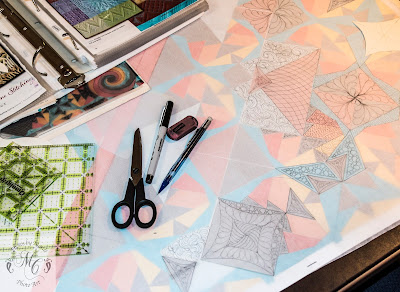Last week I wrote about how I will mark the black border on my quilt. Seredipitously (is that a word?) Jenny Lyons of
Quilt Skipper wrote her blog last week on marking black fabric. She did a lot of research on numerous markers and her discoveries are well worth reading. Guess what: her choice is the Sewline pencil...same as mine! Always nice to be validated.
I have spent the last couple of weeks doing just about everything except sewing although I got my quilt sandwiched and pinned. I have a long, narrow table (22" x 60") fitted up as an ironing surface, but when it comes to putting my sandwich together I take all the cushy covering stuff off and work right on the plywood so I don't pin the ironing cover into my quilt. How do I pin a quilt on such a narrow surface? It is not hard.
1. I carefully mark the center of my table with two pins covered by masking tape so I can feel them through the fabric. That way backing, batting and quilt top are all in the right place in the center.
 |
| Pins secured to mark center and touch sensitive. |
TIP: Batting and backing should be at least 2 inches bigger than the quilt top
on all sides.
2. Use office clips to secure the backing to the table centering it over the pins. Align the ends exactly parallel with the table ends and perpendicular with the long edges of the table. I also have pencil marks on the plywood as guides. Secure the backing fabric snug and smooth, but don't stretch it tight. If necessary use painter's tape to secure places where you can't use clamps (the end of my table).
 |
| Office clamp in place. |
3. Add the batting. Center it over the pins and make sure the edges are straight. Pat it out gently to eliminate all the bumps. DO NOT STRETCH.
4. Follow the same procedure in placing the quilt top. Be sure it is centered, straight and does not overlap the edges of backing and batting. Smooth it.
5. Now the fun begins! Starting at the center place safety pins 2-4 inches apart, working out toward both sides, top and bottom.
6. Now the tricky part. When you have covered all you can with pins, fold the top and batting toward you as far as the pins allow. Undo all the office clamps, front and back. Now carefully slide the whole thing toward you the width of the table and once again clamp the backing to the back of the table. Unfold the batting and pat it down. Everything nice and smooth. Gently lay the quilt top over the batting. No need to clamp the forward part of the quilt because the pins add enough weight to maintain adequate tension on the backing.
7. Pin your heart out and repeat if necessary. When half of the quilt is pinned let it drop off the back of the table. Smooth and clamp the backing to the front of the table, pat the batting and quilt top down and pin.
 |
All pinned (clamps are for the photo only to keep it from slipping
now that the job is all done). Light spots are sun from the window above. |
When I am done I toss the pinned quilt upside down on my bed to make sure I have no puckers in the backing. I have never had any. The only downside is having to take the ironing cover and padding off and replacing it, but what a great opportunity to wash it if necessary.
8. The final step is to fold the excess batting and backing over the quilt top edges, enclosing the batting within the backing fabric. Pin it down. This keeps the batting from leaking fibers all over the quilt. See the fibers on the black fabric above? It can be a mess. I use a lint roller constantly as I quilt.
An aside: Clearly, I use pins. I do not like the adhesives or fusible because I don't trust them. I wrestle my quilt all over the place when I quilt on my domestic machine and dread the horror of anything that might not hold together. I also secure all the seams with stitching in the ditch with invisible thread. All the pins, except the edge come out when that is done so the quilt isn't so heavy and the fancy quilting is much easier.
Sew some happy seams this week. Remember, you don't have to crawl all over the floor to pin a quilt sandwich (unless you want to).




















